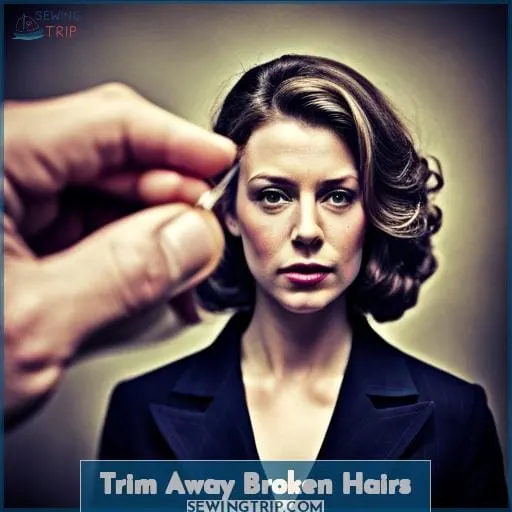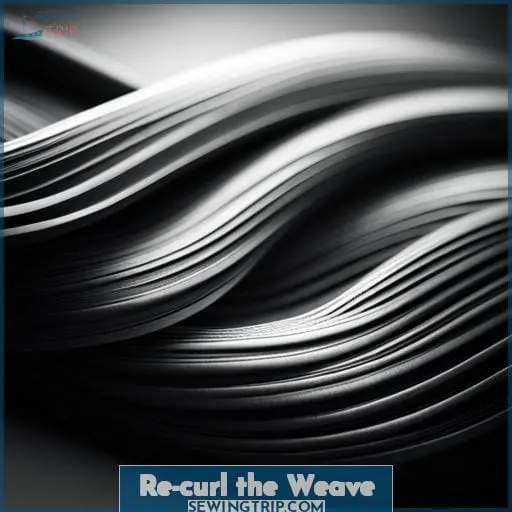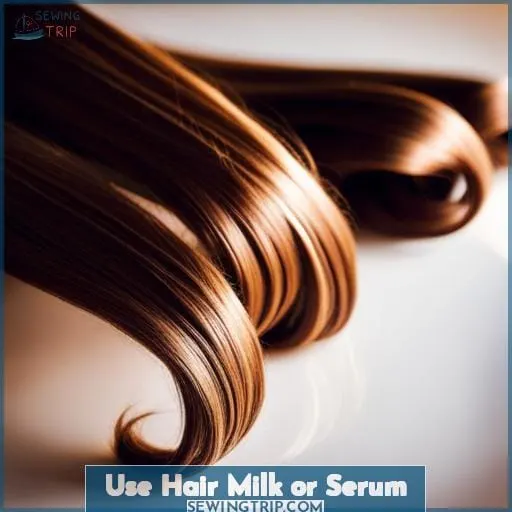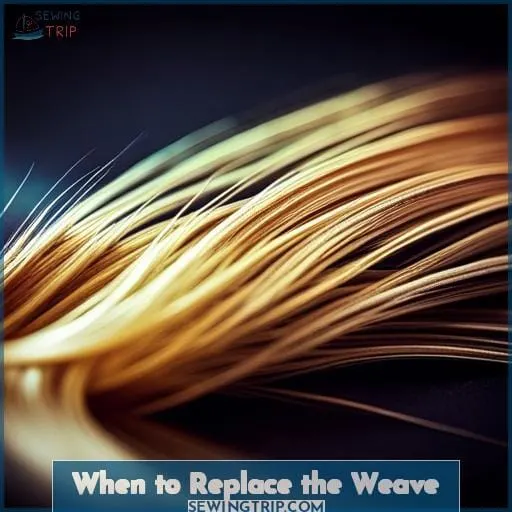This site is supported by our readers. We may earn a commission, at no cost to you, if you purchase through links.
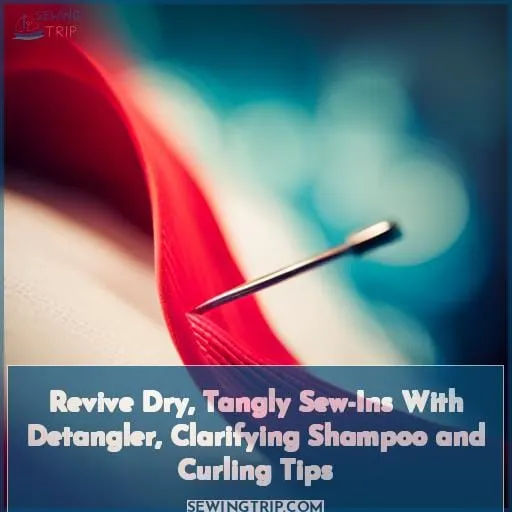 You’ve felt it – that moment when your sew-in starts to look tired.
You’ve felt it – that moment when your sew-in starts to look tired.
The hair is dry, tangly, and shedding everywhere.
Don’t stress! With some TLC, you can breathe new life into your weave.
Detangle gently.
Soak in apple cider vinegar and condition thoroughly.
Wash with clarifying shampoo.
Re-define curls with hair milk or serum.
Cover thinning spots.
Know when it’s time to replace it.
Follow these revival tips, and your hair will look fresh again.
Table Of Contents
Key Takeaways
- To maintain weave health, detangle knots, soak in apple cider vinegar, apply a moisturizing conditioner, wash with clarifying shampoo, and use leave-in conditioner or co-wash.
- To style a weave, create curls with curlers or a flat iron, define curls with hair milk or serum, secure curls with bobby pins, and finish with hairspray.
- Conceal thinning areas with hair fibers, root touch-up spray, touch-up color, braids, or wigs, and focus on natural hair care.
- Replace a weave when there’s excessive shedding, scalp issues, or follicle damage; prioritize natural hair health and consider alternative styling options.
Detangle and Condition the Weave
When your sew-in starts to tangle and mat, don’t despair. With the right tools, you can revive it.
First, focus on gently detangling with a wig brush.
Then, give your weave a good soak in an apple cider vinegar solution.
Finally, use a moisturizing conditioner to restore softness and manageability.
Use a Detangling Brush
Prior to working the detangler through your weave, start by gently brushing out knots with a wig brush made specifically for extensions.
Opt for one with flexible plastic bristles that won’t snag hair; clean it regularly by hand or machine washing to keep bristles debris-free.
Work in sections, holding hair taut above knots.
Use light, fluttering strokes instead of raking to painlessly remove tangles without excessive pull on fragile strands.
Rotating brush horizontally, vertically, and diagonally ensures multi-directional tension for stubborn mattes.
With patience, you can lift sew-ins from drab to fab.
Soak in Apple Cider Vinegar
Once you’ve finished using a detangling brush, soak the weave in an apple cider vinegar solution for additional smoothing and conditioning.
Mix two cups of apple cider vinegar with eight cups of water and submerge the weave for 20 minutes before rinsing thoroughly.
- Helps restore hair’s natural pH balance.
- Removes product buildup from the hair.
- An easy at-home remedy for itchy scalp.
Condition Thoroughly
By using a moisturizing or detangling conditioner on the weave, you’re focusing the conditioning through the ends.
Saturate the weave with conditioner and place it in a resealable bag for 30 minutes for a deep conditioning treatment.
Leave-in conditioners or a detailed co-washing routine help maintain moisture balance and avoid further tangling.
Wash the Weave With Clarifying Shampoo
After detangling and conditioning your weave thoroughly, you’ll need to wash it with a clarifying shampoo.
This will help remove any product buildup that could be weighing your hair down.
Make sure to really work the shampoo into your weave from root to tip, then rinse it out completely.
Now your hair will be clean and ready for re-styling.
Use a sulfate-based, deep cleaning shampoo formulated to remove oils and product buildup.
Look for ingredients like sulfates and citric acid.
Focus on the roots and lengths, scrubbing gently to lift dirt and oils.
Rinse with cool water until the suds are completely gone.
Warm water can cause more tangles.
Clarifying shampoos are very stripping, so only use them every 2-3 weeks.
Overuse can dry out your weave.
Now the oils and residue have been washed away, leaving your weave fresh and ready for restyling.
The deep clean will help revitalize limp, lackluster hair.
Try a Bleach Bath for Severe Tangles
If your sew-in is matted beyond belief, reach for the bleach.
We’ve all been there – months into your install and suddenly your tracks resemble a bird’s nest.
Before you cut your losses and remove the hair, give a bleach bath a shot.
Mix a teaspoon of plain bleach per cup of hot water.
Test on a shed hair first to check for color fade risk and damage risk.
If all looks well, submerge the tangles for 1-2 minutes max.
The bleach helps swell and loosen knots.
Rinse thoroughly until only natural pink tones result.
While chemical hair processes require safety precautions, a diluted bleach bath is gentler than overlapping endless detangling sessions.
Avoid overprocessing, which risks brittleness down the line.
Once detangled, deep condition to restore moisture.
With some TLC, you may get a few more weeks from your install.
| Color Fade Risk | Damage Risk |
|---|---|
| High | High |
| Medium | Medium |
| Low | Low |
Now your sew-in looks refreshed, not ragged.
By troubleshooting tangles early and gently, your hair will thank you.
Trim Away Broken Hairs
Having tried the bleach bath for severe tangles, now you’ll want to trim away any broken hairs.
Carefully evaluate the length of the weave and snip away any split ends or broken strands to:
- Remove damage and prevent further breakage
- Improve volume and shape
- Promote healthy regrowth
- Enhance the overall look
Be very precise as you snip to avoid cutting too much length unnecessarily.
Focus on split and broken ends first.
Then you can make minor trims across the weft to remove some damage and refresh the ends.
Regular trimming will keep the weave in optimal condition, allowing you to prolong the life between installs.
Take your time to carefully trim and evaluate the results frequently.
With a good trim, your weave will look refreshed, voluminous, and healthy.
Re-curl the Weave
You can re-curl the weave using curlers or a curling iron.
A curling iron is great for creating tight, defined curls, while curlers offer a more natural look.
If you’re using a curling iron, start with small sections of hair and wrap them around the barrel, holding them in place for a few seconds.
For curlers, roll the hair around the curler and secure it with a clip.
Once the hair is curled, let it cool completely before brushing it out.
Experiment with different rolling curler types to achieve various curl patterns.
Pin curls create tight, spiral curls, while flexi rods produce looser, beachy waves.
You can also use a flat iron to create curls by wrapping small sections of hair around the iron and pulling it through.
Secure the curls with bobby pins until they cool, then remove the pins and style as desired.
Finish off your look with a light mist of hairspray to hold the curls in place.
Choose a hold strength that suits your desired style.
For a more natural look, opt for a light or medium hold hairspray.
If you want your curls to last all day, use a strong hold hairspray.
Use Hair Milk or Serum
Bring your sew-in back to life by moisturizing it with a hair milk or serum.
These products help define curls and add shine, leaving your sew-in looking refreshed and rejuvenated.
Apply a small amount to your hair, focusing on the ends.
Style as desired.
Define Curls
With a dollop of hair milk or serum applied between your palms, glide your hands over your curls to define them. Feel the ringlets spring to life as you gently coax them into shape. Your fingers, like tiny sculptors, mold and sculpt each curl, bringing out its natural beauty.
Embrace Your Curl Pattern:
Don’t fight your curls; embrace their unique shape and texture. Let them dance freely, showcasing your individuality.
Provide Nourishment:
Your curls crave nourishment, so feed them with products rich in oils and butters. Let them drink deeply of hydration and shine.
Avoid Harsh Chemicals:
Be gentle with your curls; harsh chemicals can strip them of their natural oils, leaving them dry and brittle. Opt for sulfate-free and paraben-free products.
Style with Care:
When styling your curls, use techniques that preserve their integrity. Avoid tight ponytails or buns that can cause breakage.
Add Shine
- To add shine and smoothness, apply a dime-sized amount of hair milk or serum to your sew-in. These products often contain ingredients like argan oil, which nourishes and hydrates the hair, leaving it with a healthy sheen.
| Product | Purpose | Benefits |
|---|---|---|
| Shine Serums | Adds instant shine and gloss | Enhances hair’s natural radiance |
| Styling Gels | Provides hold and definition | Controls frizz and flyaways |
| Hair Glosses | Smooths and conditions the hair | Creates a sleek, polished look |
| Leave-In Conditioners | Detangles and moisturizes the hair | Improves manageability and prevents breakage |
| Argan Oil | Nourishes and hydrates the hair | Restores shine and softness |
Hide Thinning Areas
If you’re starting to see your scalp peek through your sew-in, don’t fret.
Hair fibers can fill in those gaps in a snap,
and a root touch-up spray can camouflage any signs of new growth.
Use Hair Fibers
Add volume and conceal thinning areas with hair fibers, a temporary solution that offers instant results.
To achieve a natural look, select hair fibers that closely match your hair color. Sprinkle the fibers onto the scalp, focusing on sparse areas. Synthetic or human hair fibers are both suitable, depending on your preference and budget.
To blend the fibers seamlessly, gently pat and massage the scalp.
Hair fibers are an excellent option for lace front maintenance, allowing you to conceal the lace and create a more natural hairline.
Embrace your styling versatility by experimenting with different hairstyles and colors without damaging your natural hair.
Try a Root Touch-Up
Try a root touch-up spray to quickly cover up thinning areas at the roots. With a few quick spritzes, you can camouflage new growth and extend the life of your weave. Touch-up sprays come in a variety of shades to match your hair color, so you can find one that blends seamlessly.
| Touch-Up Method | Application | Coverage | Longevity |
|---|---|---|---|
| Touch-Up Spray | Spray directly onto roots | Light to medium | Lasts until next wash |
| Touch-Up Marker | Draw along the part line | Precise | Lasts until next wash |
| Touch-Up Pencil | Fill in gaps between strands | Precise | Lasts until next wash |
| Touch-Up Powder | Apply with a brush or sponge | Buildable | Lasts until next wash |
For a more permanent solution, consider touch-up color. This is a semi-permanent hair color that can be applied to your roots to blend them with the rest of your hair.
When to Replace the Weave
Recognize it’s time for a change when:
- Excess shedding
- Severe thinning
Become your sew-in’s reality.
Embrace the refresh that comes with starting anew.
Excess Shedding
When shedding becomes noticeable after each wash or styling session, it’s time to bid farewell to your sew-in.
Excessive shedding is a sign that the weave has reached the end of its lifespan. Continued use can lead to damage to your natural hair and scalp.
It’s crucial to prioritize the health of your natural hair. Give it a break from the strain of extensions and allow it to breathe and rejuvenate.
This is an opportunity to focus on natural hair care, deep conditioning treatments, and protective hairstyles that promote growth and strength.
Consider alternative styling options like braids, twists, or wigs that offer versatility and protection.
Embrace your natural beauty and explore new ways to express your unique style without compromising the health of your hair.
Severe Thinning
If thinning becomes severe along with excessive shedding, it’s time to replace the weave.
Thinning can signal scalp health issues and potential follicle damage.
Removing the weave at this point is crucial to prevent further hair loss.
Post-removal care is essential:
- Moisturize your scalp.
- Avoid tight hairstyles.
- Give your hair a break from extensions.
Frequently Asked Questions (FAQs)
What are some tips for blending natural hair with a sew-in weave to achieve a seamless look?
To blend your natural hair seamlessly with your sew-in weave:
Prep your hair with a moisturizing leave-in conditioner.
Section your hair into small pieces.
Use a crochet hook to attach the extensions to your own hair.
Style your hair as desired, using products designed for both natural and synthetic hair.
How can I prevent my scalp from itching and irritation when wearing a sew-in weave?
When a weave’s embrace turns itchy,
Don’t let irritation reign.
Soothe your scalp’s plea with gentle care,
A soothing touch, a balm’s embrace.
Restore harmony, let comfort bloom,
And reclaim your crown’s blissful repose.
Is it possible to style a sew-in weave in different ways, such as buns, ponytails, or braids?
With weaves, you can sport buns, ponytails, and braids like a style chameleon.
Transform your look in a snap, expressing your creativity and rocking diverse styles that match your every mood.
How often should I take breaks from wearing a sew-in weave to allow my natural hair to rest and recover?
Every weave’s journey has an end.
Like a loyal steed, your natural hair needs respite from the weight of extensions.
Give it a breather every 8 to 12 weeks, letting it bask in its own glory and regain its strength.
Are there any specific products or treatments that are recommended for maintaining the health and longevity of a sew-in weave?
To keep your sew-in weave looking lush:
Try a revitalizing apple cider vinegar soak.
Follow with a clarifying shampoo and deep conditioning treatment.
Regular maintenance ensures your weave stays vibrant and healthy.
Conclusion
With a little effort and the right products, you can bring your tired sew-in back to life, saving you both time and money.
Follow these steps to restore your weave’s vibrancy, and you’ll be rocking a fresh, fabulous style in no time.
So, don’t let a dry, tangly sew-in get you down – revive it and keep slaying!




